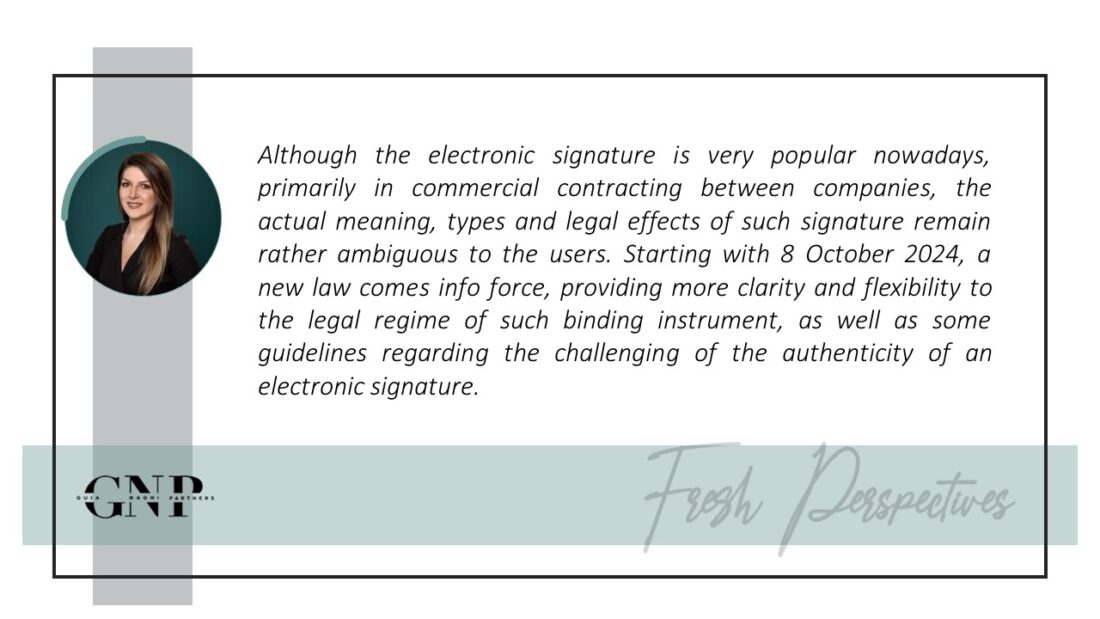Adelina Iordache – ELECTRONIC SIGNATURE – WIDELY USED, LESS UNDERSTOOD
The need for flexibility and speed has recently become universally applicable throughout the most areas of daily life, and legal field makes no exception. Mainly starting from the Covid-19 pandemic and due to mobility constrains, the electronic signature is used more and more for various legal deeds, primarily for contracting between companies.
Despite its popularity, the electronic signature did not benefit of a thorough legal framework, but merely introduced by an old law, Law no. 455/2001 on electronic signature, which was lacunar and partly discrepant compared to EU Regulation no. 910/2014 on electronic identification and trust services for electronic transactions in the internal market (“eIDAS”). A definite rule under the said law was that only the qualified electronic signature produces the same legal effects as the wet-ink signature, thus many entities were reluctant to apply or accept any other type of electronic signature.
In the attempt to overpass these shortcomings, the Parliament adopted the Law no. 214/2024 on electronic signature, temporal stamp and the provision of trust services (the “Electronic Signature Law”), published in the Official Gazette of 8 July 2024, which is to enter into force on 8 October 2024. As of the same time, the former Law no. 455/2001 on electronic signature will be repealed and fully replaced by the Electronic Signature Law.
The Electronic Signature Law was drafted to alleviate the direct application of eIDAS, thus it will be supplemented in certain regards by the provisions of the European Regulation. Also, the Electronic Signature Law will be supplemented or replaced by any special rules regulating the specific legal deed to be concluded, if the case.
The Electronic Signature Law regulates three types of electronic signatures, but only defines the basic electronic signature, referring to eIDAS for the meaning of the other two types:
- the “basic electronic signature” (in Romanian: „semnatura electronica simpla”), is an electronic signature which does not meet at least one of the requirements provided for advanced electronic signature;
- the “advanced electronic signature” is the electronic signature which meets all the following requirements:
- it is uniquely linked to the signatory; and
- it is capable of identifying the signatory; and
- it is created using electronic signature creation data that the signatory can, with a high level of confidence, use under his sole control; and
- it is linked to the data signed therewith in such a way that any subsequent change in the data is detectable.
- the “qualified electronic signature” is an advanced electronic signature that is created by a qualified electronic signature creation device, and which is based on a qualified certificate for electronic signatures.
Regarding the legal effects, the Electronic Signature Law provides that all three types of signatures generate the same effects as a handwritten signature, if they fulfil certain legal conditions.
The basic electronic signature is assimilated to a handwritten document when:
- Recognised by its issuer, either directly, or indirectly (by cert actions of partial or full execution / implementation of such deed); or
- Applied on a document having a monetary value below the equivalent of half of the gross national minimum wage; or
- Only between legal entities, when the parties have expressly agreed upon to use a basic electronic signature between themselves, under a previous and separate document signed by handwritten or qualified electronic signature;
and
- The written form of the document is legally required only for probation purposes (and not for validity purposes).
The advanced electronic signature can also produce the same effects as a handwritten signature when:
- The advance signature is applied based on an advance electronic signature certificate; or
- The signature is recognised by its issuer, either directly, or indirectly (by cert actions of partial or full execution / implementation of such deed); or
- Only between legal entities, when the parties have expressly agreed upon to use an advance electronic signature between themselves, under a previous and separate document signed by handwritten or qualified electronic signature.
The qualified electronic signature produces the same effects as a handwritten signature, no additional conditions being required.
The qualified electronic signatures can be applied only based on a qualified certificate for electronic signature. The advanced electronic signatures may also be applied based on an advanced certificate for electronic signature. Such advanced or qualified certificates for electronic signature are issued by qualified trust services providers, duly authorized by the competent supervisory authority. Each Member State establishes, maintains and publishes a
Trusted List[1] with authorised trust services providers, as well as information related to the services they provide, such as, for example, advanced or qualified electronic certificates and signatures.
If an advanced or basic electronic signature is contested or not recognised by its issuer (neither directly, nor indirectly), the validity of the signature is to be proved by the party claiming for its authenticity. If a qualified electronic signature is contested or not recognised by its issuer, the probation burden lies with the contesting party.
In case of arguments with respect to the validity of the electronic signature, the court of law or the interested party, as the case might be, may refer to: specialized technical expertise to determine if the signature belongs to the alleged signatory, publicly available verification tools approved by the specialized supervising authority, or verification by the provider of the advanced electronic signature.
The considerations herein are generally applicable to Romanian companies, in their usual B2B commercial activity. Additional requirements or derogatory provisions may become incident either due to a special nature of the legal deed (such as notarial deeds) or the contracting party (such as individual employment agreements).
[1] The Trusted List of Each Member State may be found at the following link: https://eidas.ec.europa.eu/efda/tl-browser/#/screen/home; The Trusted List issued by Romania may be found at the following link: https://eidas.ec.europa.eu/efda/tl-browser/#/screen/tl/RO





No Comments